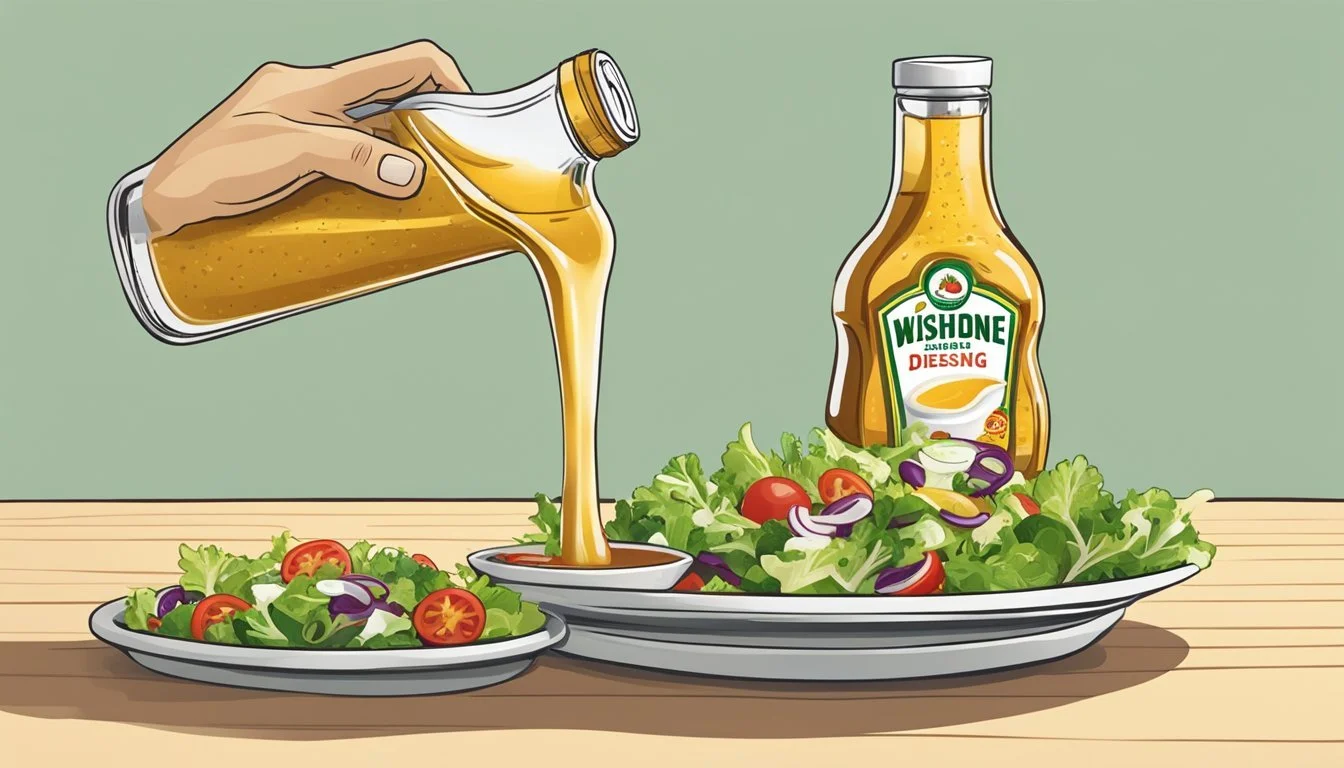How Much Wishbone Italian Dressing Per Day Is Excessive
Daily Intake Guidelines
Determining the appropriate amount of Wishbone Italian dressing to consume daily involves understanding its nutritional content and considering dietary guidelines. This popular brand of Italian dressing features a blend of herbs, spices, and oils that deliver a robust flavor profile to salads, marinades, and other dishes. While it can enhance the taste of various foods, moderation is key due to its caloric content and the presence of fats in the oils used.
Italian dressing, like many condiments, should be used to complement a balanced diet. For health-conscious individuals, it's important to acknowledge that even though Wishbone Italian dressing offers certain culinary benefits, it also contains calories and fat. The dressing's nutritional value and the amount an individual should consume can vary based on personal health goals, dietary restrictions, and overall meal planning.
In light of these factors, it's crucial to employ mindful eating habits, particularly when incorporating dressings into meals. Using too much dressing can inadvertently lead to excess caloric intake, which might have implications for weight management and heart health. As a result, consumers are often advised to be cautious with portion sizes and to consider healthier substitutions or modifications to maintain a well-rounded, nutritious diet.
Nutritional Overview
Wishbone Italian dressing provides a blend of fats, minimal protein, and carbohydrates in the form of sugar. It is important for consumers to understand how the dressing contributes to their daily nutritional goals.
Calories and Macronutrients
Calories: A serving of 2 tablespoons (30 ml) of Wishbone Italian dressing contains approximately 90 calories.
Total Fat: There is about 7 grams of fat per serving, which contributes to 87% of the total calorie content.
Carbohydrates: A serving has around 13% of calories from carbs, equating to roughly 3-4 grams per serving, primarily from added sugars.
Protein: This dressing contains negligible amounts of protein, contributing 0% to its caloric makeup.
Micronutrients and Daily Values
Wishbone Italian dressing is not a significant source of dietary fiber or protein, and it contains minimal micronutrients. Any vitamins, minerals, or additional nutritional benefits are present in small amounts and vary depending on the recipe. For instance:
Vitamin E and essential fatty acids may be present due to the inclusion of oils.
The exact percentages of Daily Values (DV) for micronutrients like calcium, iron, potassium, and sodium are not typically high and will not contribute substantially to the recommended daily intakes.
Saturated and Trans Fats Content
Saturated Fat: The specific content of saturated fat can vary, but it is generally lower compared to unsaturated fat due to the use of vegetable oils.
Trans Fats: Wishbone Italian dressing does not list trans fats, which are often minimal or absent in such products. The use of hydrogenated oils, which contain trans fats, is not a common practice in oil-based dressings, but consumers should always check the label for confirmation.
Guidelines for Consumption
Determining the appropriate amount of Wishbone Italian dressing to consume involves understanding serving sizes and the potential health implications of exceeding them.
Serving Size Recommendations
A single serving of Wishbone House Italian Dressing is 2 tablespoons. According to the product's nutrition facts, a serving contains about 90 calories and 9 grams of fat, which constitutes 14% of the Daily Value (DV) for fat, based on a 2,000 calorie diet. For a balanced diet, individuals should consider these values when adding dressing to their meals. Individuals aiming for weight loss or a heart-healthy diet should be cautious, as dressings can add significant amounts of calories and fat.
Suggested Servings: To maintain a balanced diet, sticking to one serving per meal is advisable.
Potential Health Implications
Sodium Content: With high sodium contents approaching 150 milligrams per tablespoon, overconsumption can contribute to increased blood pressure, posing a risk for heart disease and stroke.
Daily Value: It's important to note that consuming more than the recommended serving size can lead to an intake of calories and fats beyond the recommended daily values, hindering weight loss goals and affecting cardiovascular health.
Consumers should pay attention to their overall daily nutrient intake to ensure that the amount of Italian dressing consumed does not cause them to exceed their nutritional needs or jeopardize their health objectives.
Ingredients Analysis
When assessing how much Wishbone Italian dressing to consume daily, scrutinizing its ingredients is crucial. This analysis will look at the types of oils and fats used, additives and seasonings included for flavor and preservation, and potential allergens or dietary restrictions that may influence consumption recommendations.
Oils and Fats in Italian Dressing
Wishbone Italian dressing primarily uses vegetable oil and may include extra virgin olive oil. These oils contain a mix of saturated, monounsaturated, and polyunsaturated fats. While olive oil is known for its heart-healthy properties, the presence of other vegetable oils may contribute to the overall calorie and fat content. Too much consumption of dressings high in fats can lead to an increased intake of calories.
Oils typically found in Wishbone Italian Dressing:
Vegetable oil (canola, soybean, and/or corn oil)
Extra virgin olive oil
Additives and Seasonings
Wishbone Italian dressing contains a variety of seasonings like salt, pepper, onion, garlic, and oregano, which provide the dressing's distinctive flavor. However, it also contains additives for preservation and texture. High consumption of these additives should be watched, as too much sodium from salt can lead to health issues.
Common additives and seasonings:
Vinegar (for tang)
Salt (watch for overconsumption)
Herbs and spices (e.g., garlic, onion, oregano)
Sweeteners (such as sugar or honey)
Thickeners and preservatives (to maintain shelf-life and consistency)
Allergens and Dietary Considerations
Wishbone Italian Dressing is labeled gluten-free and may be suitable for those on a vegan diet depending on the specific variety. However, individuals with allergies or sensitivities to ingredients like soy (often found in vegetable oils) or additives should consume cautiously.
Allergy and dietary information:
Gluten-Free: Safe for those with gluten intolerance.
Vegan: Check individual product labels to ensure no animal-derived ingredients.
Soy Allergies: Contains soybean oil; individuals with soy allergies should avoid it.
Homemade vs Store-Bought Italian Dressing
When assessing the impact of Italian dressing on one's daily diet, one must consider the differences between homemade and store-bought versions, particularly in terms of ingredients and nutrition, preparation, and storage options.
Comparing Ingredients and Nutrition
Homemade Italian dressing typically offers a clearer ingredient list, where a person can control the amount and quality of each element. A standard recipe might include olive oil, vinegar, minced garlic, Dijon mustard, herbs, and a pinch of salt and pepper. Nutrient-wise, homemade dressing can be tailored to reduce sugar and sodium levels, unlike many store-bought dressings, such as Good Seasons Italian Dressing, which may contain additional preservatives and flavor enhancers.
Ingredients Homemade Italian Dressing Good Seasons Italian Dressing Base Oil Olive oil Soybean oil or canola oil Vinegar White wine vinegar Distilled vinegar Herb Flavorings Fresh or dried herbs Dried spices and flavorings Sweeteners Optional, to taste Sugar, corn syrup Emulsifiers Mustard, mayonnaise Xanthan gum, guar gum Preservatives None Potassium sorbate, calcium disodium EDTA
Making Your Italian Dressing
The process for making Italian dressing at home is straightforward: one combines oil, vinegar, and flavorings in a jar or bottle. The ingredients are then shaken or whisked until they are emulsified. This creates a fresh dressing without the need for artificial additives. A homemade dressing not only allows for customization of flavors but also enables the option to create a sugar-free variant by omitting sweeteners.
Storage Tips
Homemade dressings typically lack the preservatives found in store-bought dressings, which means they have a shorter shelf life and must be stored properly to maintain their quality. It is advisable to store homemade Italian dressing in the fridge, in a jar with a tight-fitting lid for up to two weeks. If the oil solidifies, letting the dressing sit at room temperature before shaking can recombine the ingredients. In contrast, most commercial dressings, like those found in stores, have stabilizers that prevent separation and can often be stored for longer periods.
Culinary Uses
Wishbone Italian dressing is a versatile condiment that can enhance a variety of dishes with its vinaigrette base and blend of herbs like basil. It is often used as a marinade or a flavorful addition to salads and sides.
Salads and Marinades
Wishbone Italian dressing serves as a staple marinade and salad dressing, bringing a tangy and herby flavor to dishes. For salads, a generous drizzle can enliven greens, chopped vegetables such as cucumbers and bell peppers, and add a zest to salads incorporating meats like salami or ham. The vinaigrette acts both as a flavor enhancer and a method to tenderize meats when used as a marinade. To maximize taste, marinate proteins like chicken or tuna for at least 30 minutes before grilling or baking.
Chicken: Marinate for at least 1 hour
Beef: Marinate for 2-4 hours
Fish: Marinate for 30 minutes
Pasta and Side Dishes
In pasta dishes, Wishbone Italian dressing offers a quick and easy way to dress pasta salads. Mix the dressing with cooled pasta, adding parmesan cheese, salami, ham, or tuna for a flavorful meal. For side dishes, tossing vegetables with the dressing before roasting can create a delicious, healthy choice. A light coating is typically sufficient to provide flavor without overwhelming the dish.
Pasta Salad Mix-ins:
Vegetables: Bell peppers, cucumbers (chopped)
Cheese: Parmesan (grated), crumbled feta
Meats: Salami, ham (chopped), tuna
Creative Cooking Ideas
The robust flavor of Wishbone Italian dressing invites creative applications beyond traditional uses. Experiment with a drizzle over roasted potatoes or mixed into rice sides for an Italian twist. For a unique appetizer, mix the dressing with crumbled feta and serve it with fresh bread. The key is to use the dressing as a foundation for flavor development while adapting it to complement your favorite dishes.
Creative Cooking Applications:
Roasted potatoes: Light coating before roasting
Rice dishes: Mix in for an Italian flair
Appetizer: Mix with crumbled feta for a dip
Health Considerations
When considering the intake of Wishbone Italian dressing, a consumer should be aware of the diet and weight loss implications as well as the potential correlation with chronic diseases. The dressing's ingredients and nutritional profile can affect these areas depending on the amount and frequency of consumption.
Impact on Diet and Weight Loss
Wishbone Italian dressing, like many dressings, can add significant flavor to meals. However, its calories primarily come from fats and carbohydrates. For those focusing on weight loss, monitoring dressing intake is essential since it can lead to excess calorie consumption. A serving of Wishbone Italian dressing generally contains around 80 calories with fats accounting for the majority of these calories.
Fat-Free Versions: Opting for fat-free versions might seem healthier. However, they often contain added sugars or other carbohydrates to compensate for flavor, which can inadvertently hinder weight loss efforts.
Correlation with Chronic Diseases
Dressings like Wishbone Italian, which are processed, have been associated with heart health due to their fat content.
Heart-Healthy Fats: Using dressings made with oils such as canola oil can provide heart-healthy monounsaturated fats. These are preferable to saturated fats and may be beneficial when consumed in moderation.
Sodium and Additives: High sodium levels and additives often found in processed dressings may negatively impact health, potentially contributing to hypertension and other chronic diseases.
It is important for the consumer to recognize the balance between enjoying the zesty Italian dressing for its rich flavor and considering its health implications when consumed in large quantities.








